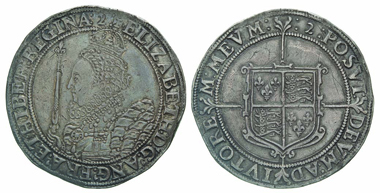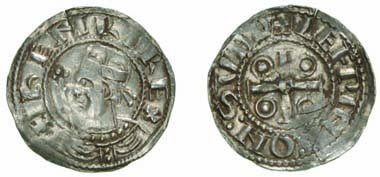06-11-2013 – 01-01-1970
Auction 66
Sale of Coins, Medals and Banknotes
A collection of English crowns dating from the first issues of Edward VI in 1551 features in a sale by London specialist coin and medal auctioneers Morton & Eden on Thursday 7 November, to be held at Sotheby’s galleries in London. The collection, formed many years ago, comprises over 40 coins and is expected to realise in the region of £50,000.
Pick of the collection is an Elizabeth I crown, with the mint mark “2”, indicating that it was struck in 1602, examples of which are seen only rarely. When they are, their condition is poor in comparison to the present coin, which is described as being “very fine and with a clear portrait”. Illustrated on the front cover of the sale catalogue, it is estimated at £7,000-10,000.
From another owner and among the earliest English coins in the sale, is a very rare Henry I cross and annulets silver penny, struck by the moneyer Leofwine at the Southwark mint in circa 1113. With an official edge snick (test mark), the coin has a strong portrait, which shows the bust of the crowned monarch with a sceptre and it is estimated at £4,000-6,000.
Notable among the foreign coins in the sale is an example of Siamese so-called bullet money, a rare silver 2 baht of 1880 which commemorates the cremation of Somdet P’ra Deb Sirindhra, the mother of Rama V (1853-1910). He was known as the Royal Buddha and considered one of the greatest kings of Siam. The coin is decorated with three countermarks of an ornate chakra wheel, a Thai flower with the local date 1242 (AD 1880) below, and an ornate royal crown. It is estimated at £1,000-1,200 (a rarer 20 baht of this same coinage sold in our sale in June for £20,400)
An extremely rare coin issued during the brief period in the 16th century when Portugal was without a ruler is a highlight among European coins.
The Portuguese throne became vacant when Dom Henrique I “the Chaste”, a cardinal, died on January 31 1580 without leaving an heir or agreed successor. There were many claimants, so a temporary council of five governors, the Governadores do Reino (The Council of Regency) was formed. Dom António raised an army to support his claim, as did the Duke of Alba in the name of Philip II of Spain, the former being proclaimed king of Portugal at Santarem on 19 June 1580, on the same day as the latter crossed the frontier. Coins issued during this brief interregnum of just over 4 months are extremely rare, especially the silver issues like the tostão (100-reais) example in the sale, which is estimated at £4,000-5,000.
The top priced coin in the sale is a particularly fine Syracusan decadrachm of around 400 BC signed by the artist Kimon. Such coins are considered to have been made as a victory issue to commemorate the defeat of the Carthaginians in 405 BC and the present example has an impressive provenance having featured in a Swiss auction in 1962 and prior to that having been in the Bibliotheque Nationale in Paris (from where it was de-accessioned as a duplicate). It is estimated at £30,000-50,000.
Among other ancient coins in the auction, the Adam Smith collection of coins of Pheneos comprises many rare and interesting pieces from the 5th century BC and later. Pheneos, in the Peloponnese, had its own coinage which is dominated with images of Hermes, its patron god. The collection includes a unique half stater from the city’s earliest coinage of around 480 BC, estimated at £10,000-12,000.
The sale includes over 250 lots of Islamic coins of all the principal dynasties and the highlight here is an extremely rare Mirdasid dinar from Halab (Aleppo) dated 429h (AD 1037), issued by the ruler Shibl al-dawla and estimated at £4,000-6,000.
You can download the complete catalogue as PDF from the Morton & Eden website.
The auction is online at Sixbid.









